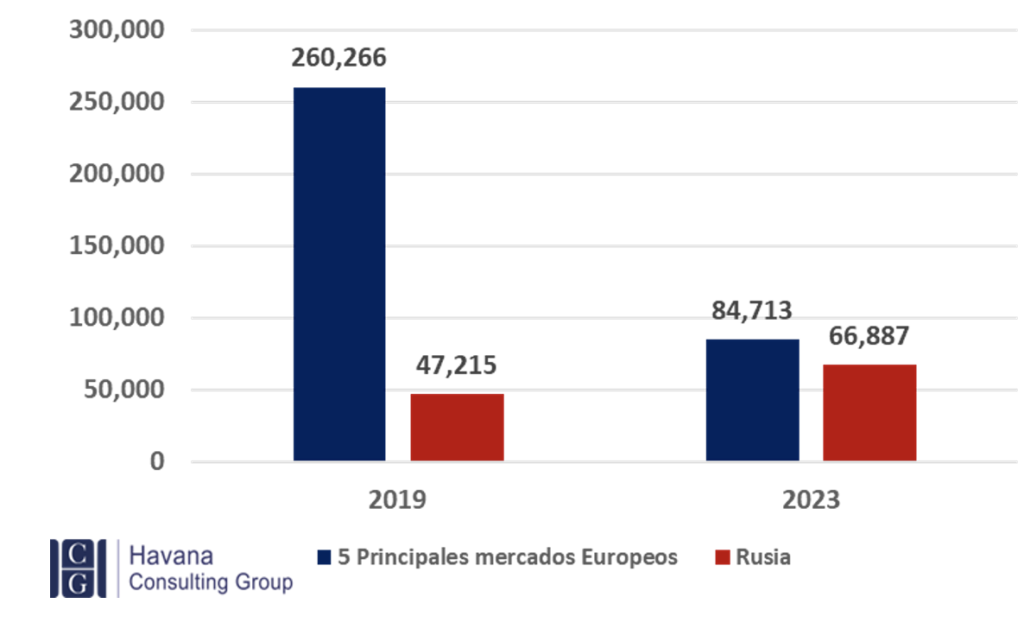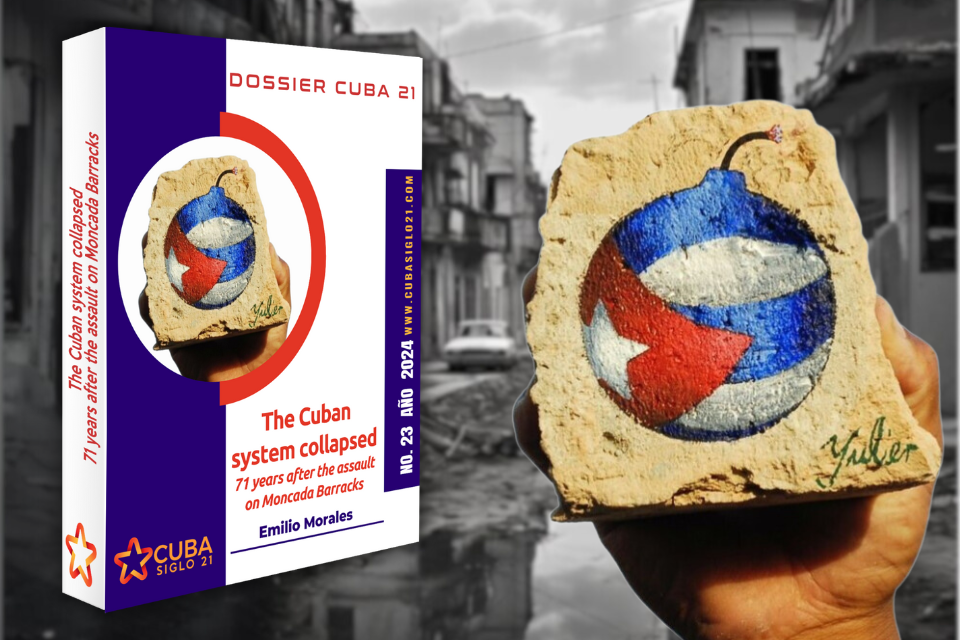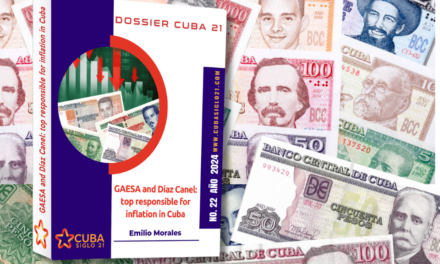Descargar informe completo en pdf
Download complete report in pdf
The sharp drop of more than 50% of the Cuba’s three main lines of income – medical exports, remittances and tourism – have hastened the collapse of the governance regime.
The celebration of the violent action that started Fidel Castro’s revolution -the assault on the Moncada Barracks in Santiago de Cuba on July 26, 1953- is not a day of celebration, nor a day of hope for the still surviving participants of these events, nor for the leadership that together with them today holds power in the country. On the contrary, it is a day that begins to mark the countdown to the extinction of the Cuban regime, given the depth of the crisis in which it is mired and its manifest incapacity to get out of it.
The export of medical services, the country’s main source of income, has fallen 78.12% compared to the value reached in 2013 when they computed 10.42 billion, the highest volume in its entire history.
Remittances, the second source of foreign currency income, have also suffered a decline. Remittances to the country experienced a drop of 3.31% with respect to 2022 (2,040.25 million), totaling only 1,972.56 million dollars. The figure reached in 2023 represents a drop of 46.93% compared to 2019, the year prior to the pandemic.
The decrease in remittances is directly related to the massive emigration following the repression after the protests of July 11, 2021. The boomerang effect of this policy has been doubly detrimental to the regime, it has considerably reduced one of its main sources of income and has decapitalized it due to the great drain of human capital. The population has contracted, aged and diminished its talent pool and productivity. It should be noted that this decapitalization of human resources is observed in all sectors of society.
There is a great deficit of teachers. There is a lack of qualified personnel in the health care system: doctors, nurses, laboratory technicians, therapists, etc. This extends to the sugar industry, tourism and the national energy system. It is even noticeable in the justice system. In this sense, the head of the Supreme Court of Justice himself, Remigio Ferro, recently acknowledged that the completion of judges is at 69% in the country.
On the other hand, the recovery of tourism after the pandemic has been a great failure. The results achieved by the Cuban tourism industry in 2023 (2,436,979) are comparable to those obtained 15 years ago when in 2009 it registered the arrival of 2,429,809 tourists.
Figure 5. Tourist arrivals to Cuba, 2007-2023.

Source: Prepared by Havana Consulting Group based on information published by the National Statistics Office (ONEI) and other sources
The great migratory wave affected the number of tourists. In 2023, 358,480 Cubans living abroad visited the country, which represented 42.55% less than the figure reached in 2019, the year prior to the pandemic. This represented the arrival of 265,495 fewer travelers.
In the first quarter of 2024, this downward trend has increased. The number of Cubans living abroad who visited the island was 75,382, which represents 46.51% less than in the same period of 2019, when they received 140,938 travelers.
This reality constitutes a hard blow to the Cuban economy, since Cubans living abroad is the tourist segment that generates the highest per capita income for the Cuban tourism industry.
One of the most serious strategic errors committed by the Cuban regime has been its support for Russia in the genocidal war against Ukraine. This bet has practically erased European tourism from the island. The arrival of travelers from Europe’s five main emitters of tourists to the island (Italy, France, Germany, Spain and England) have had a deep decline in the last three years. If we compare the first quarter of 2019 with that of 2024 we will see a decline of 67.45%. From 260,266 tourists received in the first quarter of 2019 to 84,713 in the same period of 2024. This means that 175,553 fewer tourists have traveled from these markets.
The bet on Russian tourism has been a failure. Although the arrival of Russian tourists has experienced a growth of 41.66%, the number of Russian tourists arriving in the country (66,887) does not compensate for the drop in tourism from the five main European issuing markets to Cuba. See Figure 8.
Figure 8 Comparison of tourist arrivals to Cuba from the five main European tourist source markets (Italy, Germany, France, England and Spain) vs. Russian tourism, 2019-2023

Source: National Statistics and Information Office (ONEI).
The debacle of the tourism industry is reflected in the drop in revenues from 2017 to the present day, despite the multi-million-dollar investments made in the sector in recent years. It is important to highlight that the drop in revenues started a couple of years prior to the pandemic. COVID-19 buried the Cuban tourism industry and since then it has not been able to reach the revenue figures obtained in the years prior to the pandemic. In contrast to the spectacular recovery of major competitors in the Caribbean region, Cuba’s recovery has been a disaster. In 2023, industry revenues were 45.29% lower than the figure collected in 2019, the year prior to the pandemic. Revenues earned in 2023 were $1,216.05 million, 2.61 times lower than the revenues achieved in 2017 (the highest in history) which were $3,185.90 million.
The revenues achieved in 2023 (US$1,216.05 million) are well below those achieved in 2008, 15 years ago, when they computed US$2,090.4 million. See Figure 9. This involution of the industry is a vivid portrait of the Cuban government’s incompetence in managing to move the country’s economy forward.
Conclusions
The precipitous fall of the three main lines of income of the Cuban regime by more than 50%, have hastened it into the final phase of its current terminal state. The functional incapacity of the Cuban government to implement effective mechanisms to transform the country’s economy and appease this multi-systemic crisis that has it on the verge of collapse, is living proof that the Cuban regime is totally dysfunctional.
Their political allies see it the same way, since none of them is willing to carry out a large-scale economic rescue that would allow them to survive even in the short term. The Cuban oligarchs do not have the capacity to adapt to changes; they prefer their anachronic system to maintain their power. That is why neither the Russian model, nor the Chinese model, nor the Vietnamese model have been put into practice as a new system of governance to maintain political power by opening to the market economy, as their main political allies have been doing for many years.
The massive Cuban migration stampede that occurred after the July 11 protests and which has sent 1.79 million Cubans out of the country has decapitalized the country financially and in terms of human resources.
The metamorphosis of Castroism from a socialist state to a mafia state through the consolidation of GAESA as the true political and economic power on the island has led the country to its destruction. Today, not only its industries are in ruins, but also its political capital. The PCC has run out of quarry to recycle. Many of the old militants no longer believe in the party, its leaders or ideology. Rather, they want a profound change in the country.
The horizon looks bleak for the still living protagonists of the events of July 26 and their current followers. In their political blindness and ideological stubbornness, they are not seeing the great tsunami of change that is approaching as a result of their own incompetence.
In summary: seven decades after the assault on the Moncada barracks that started Fidel Castro’s revolution, Cuba is experiencing an acute humanitarian crisis that has plunged 89% of the population into misery and has caused 1.79 million citizens to leave the country. The Cuban system has collapsed. The Cuban state is dysfunctional and bankrupt. The Cuban government is mediocre and lacks leadership. The Cuban power elite is impervious to criticism. Its downfall, by one means or another, is inevitable.
Descargar informe completo en pdf
Download complete report in pdf







